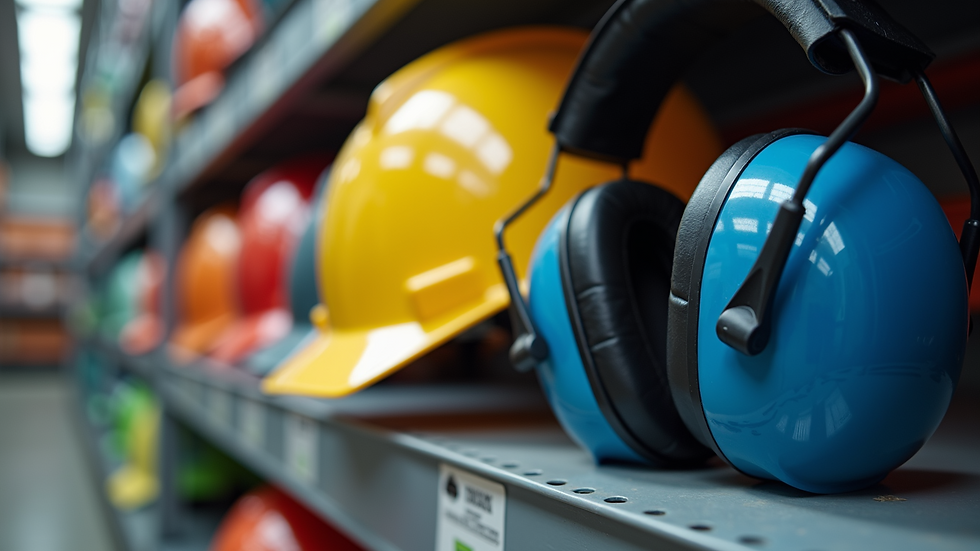Mastering Personal Protective Equipment for Safety
- jeff97795
- Aug 11
- 4 min read
When it comes to safety in industrial and environmental settings, mastering PPE essentials is non-negotiable. The right gear protects workers from hazards, reduces accidents, and ensures compliance with safety standards. I’ve seen firsthand how proper use of personal protective equipment can save lives and improve workplace efficiency. This post breaks down the essentials you need to know to get PPE right every time.
Understanding PPE Essentials: Why They Matter
PPE essentials are the foundation of workplace safety. They act as the last line of defense against physical, chemical, and biological hazards. Without them, workers face serious risks like chemical burns, respiratory issues, and physical injuries.
Here’s why PPE essentials matter:
Protection: Shields workers from harmful substances and impacts.
Compliance: Meets legal safety requirements and industry standards.
Confidence: Boosts worker morale knowing they are safe.
Productivity: Reduces downtime caused by accidents or health issues.
For example, in chemical handling, gloves and eye protection prevent burns and irritation. In noisy environments, earplugs or earmuffs protect hearing. These simple items make a huge difference.

Key PPE Essentials You Must Have
To master PPE essentials, you need to know the core items that every industrial or environmental distributor should stock and recommend. Here’s a quick rundown:
Gloves - Protect hands from chemicals, cuts, and abrasions. Choose nitrile for chemical resistance or leather for heavy-duty tasks.
Safety Glasses and Goggles - Shield eyes from splashes, dust, and flying debris.
Respirators and Masks - Filter harmful particles and gases. Use N95 masks for dust and particulate matter, and full-face respirators for chemical vapors.
Protective Clothing - Includes coveralls, aprons, and chemical-resistant suits.
Hard Hats - Protect the head from falling objects and impacts.
Ear Protection - Earplugs or earmuffs reduce noise exposure.
Foot Protection - Steel-toe boots guard against heavy objects and punctures.
Face Shields - Provide full-face protection during high-risk tasks.
High-Visibility Clothing - Ensures workers are seen in low-light or busy environments.
10. Fall Protection Gear - Harnesses and lanyards prevent injuries from falls.
Each item serves a specific purpose. Selecting the right PPE depends on the hazards present and the task at hand.

What are the 10 PPE Equipment?
Let’s dive deeper into the 10 PPE equipment items you must know. These are the staples in any safety program:
Gloves
Protect hands from chemicals, cuts, and heat. For example, nitrile gloves resist oils and solvents, while cut-resistant gloves protect against sharp tools.
Safety Glasses and Goggles
Safety glasses protect against flying debris. Goggles offer a tighter seal for chemical splashes.
Respirators and Masks
Respirators filter out harmful dust, fumes, and vapors. Masks like N95s are essential in dusty environments.
Protective Clothing
Coveralls and aprons shield skin from chemicals and contaminants.
Hard Hats
Protect the head from impact and penetration injuries.
Ear Protection
Earplugs and earmuffs reduce noise-induced hearing loss.
Foot Protection
Steel-toe boots protect feet from heavy objects and punctures.
Face Shields
Provide full-face protection during grinding, cutting, or chemical handling.
High-Visibility Clothing
Makes workers visible in low-light or high-traffic areas.
10. Fall Protection Gear
Harnesses and lanyards prevent falls from heights.
Understanding these items helps you recommend the right PPE for every situation. Always assess the risks before choosing equipment.

How to Choose the Right PPE for Your Needs
Choosing the right PPE is not guesswork. It requires a clear understanding of the hazards and the environment. Here’s how I approach it:
Conduct a Risk Assessment
Identify all potential hazards in the workplace. Chemical spills? Loud machinery? Falling objects?
Match PPE to Hazards
Use gloves for chemical exposure, ear protection for noise, and hard hats for overhead risks.
Consider Comfort and Fit
PPE must fit well to be effective. Ill-fitting gear can cause discomfort and reduce compliance.
Check Standards and Certifications
Ensure PPE meets OSHA, ANSI, or other relevant standards.
Train Workers
Proper use and maintenance of PPE are critical. Training ensures workers know how to wear and care for their gear.
Regularly Inspect and Replace
PPE wears out. Regular checks prevent failures.
For example, if you handle oil and chemical absorbents, chemical-resistant gloves and coveralls are essential. Pair these with eye protection and respirators if fumes are present.
Maintaining and Storing PPE for Longevity
Proper maintenance extends the life of PPE and keeps it effective. Here’s what I recommend:
Clean After Use
Wash reusable gloves, goggles, and clothing according to manufacturer instructions.
Inspect for Damage
Look for cracks, tears, or worn areas before each use.
Store Properly
Keep PPE in a clean, dry place away from direct sunlight and chemicals.
Replace When Needed
Don’t hesitate to replace damaged or expired PPE.
Document Maintenance
Keep records of inspections and replacements to ensure compliance.
Good maintenance saves money and keeps workers safe.
Mastering PPE essentials is about more than just having the gear. It’s about understanding the risks, choosing the right equipment, and maintaining it properly. By focusing on these areas, you can ensure safety and compliance in any industrial or environmental setting.
For more detailed information on personal protective equipment, check out the resources available to help you make the best choices for your safety needs.




















Comments